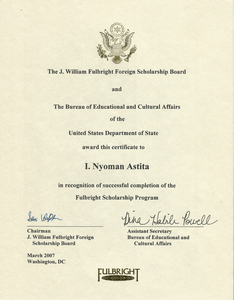Dr. I Nyoman , Astita, MA
(2006)
Court Music in Contemporary Bali.
Documentation.
Isi Denpasar.
Abstract
There is three forms of Balinese court music in contemporary Bali, Gomelan Gambuh, Gamelan Semara Pagulingan, and Gamelan Gong Gede, with examples of their compositions that date from the royal palaces, of Puri, of late 15th century Bali. This musical heritage has been perpetuated by role that it continues to serve Balinese communities as the essential music accompaniment for religious ritual, public ceremony as well as legitimate forms of popular entertainment.
These fear art forms have and prominent social importance for centuries, with distinct forms of presentation and social functions. Gambuh is considered a soft form of music, dominated by unusually long Saling Gambuh (end-blown bamboo flute) playing the leading melodies. The role of the pair drums it essential to this music and has influenced most modern forms of Balinese music today. In contrast with Gamelan Gambuh, Comelan Semar Pegulingan Saih Pitu a seventh tone scale gamelan considered to be a louder, more intricate type of music that incorporates metallophones that play rythmically dense interlocking configurations, called Kotekan the hallmark of Balinese music. Gamelan Semar Pogulingan was traditionally played within the inner, private palace courtyard. Lauder still, The Gong Gede played outdoors and at temples as royal processional music and religius music. Even today, Gong Gede is the larges gamelan orchestra found in Bali.
Actions (login required)
 |
View Item |
![[img]](http://repo.isi-dps.ac.id/1782/1.hassmallThumbnailVersion/Untitled-0.jpg)



